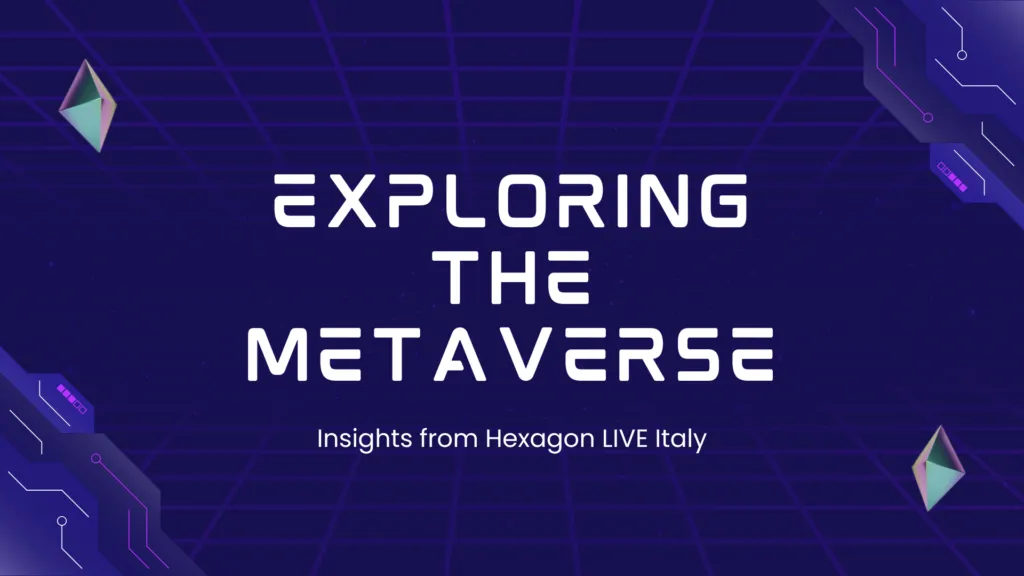
Exploring the Metaverse: Insights from Hexagon LIVE Italy
At the recent Hexagon LIVE Italy event – held at the historic Autodromo Nazionale Monza in Milan – we invited attendees to dive into the fascinating world of the metaverse.
By crafting an interactive metaverse environment, we extended the boundaries of the physical expo, equipping visitors with VR glasses to interact with 3D models in a shared, multiplayer space.
Visitors were intrigued by the hands-on metaverse experience
Some attendees – although knowledgeable about digital realities – visited the metaverse for the first time. For many, the ability to interact within the 3D model helped bridge the gap between theoretical knowledge and practical exploration and inspired real-world use cases. Many visitors instantly started imagining all the ways they might implement these virtual environments in their own work – for example, for design reviews in manufacturing, training, or offering tours of a city’s intricate underground.

The metaverse isn’t just a digital playground
Most people still associate the metaverse primarily with gaming and entertainment, but it will be most transformative where it impacts business operations. It’s already beginning to reshape how organisations collaborate, innovate and engage with stakeholders. By combining immersive experiences with tools like digital twins, and precise, dynamic representations of physical assets or processes, businesses can simulate, analyse, and optimise performance in ways previously unimaginable. New, innovative applications are constantly being discovered.
For example, the Pacific Island nation of Tuvalu created a digital twin of the entire archipelago. This has immortalised the nation’s natural landscapes, homes, and invaluable cultural heritage elements as it grapples with rising sea levels — effectively storing its identity and culture in the cloud.
Another example is a recent study from the Politecnico di Milano, which looked at the potential of the metaverse in promoting rural tourism for an Italian wine consortium. The metaverse enhanced their global visibility and connection with potential visitors, while fostering stakeholder collaboration and cohesion.
A recent Hexagon survey of 660 global executives revealed the tangible benefits of digital twins, from smarter cities to more efficient operations and sustainable processes — organisations that have integrated digital twins are seeing real, positive results.
The metaverse also offers the potential to address broader challenges, such as improving sustainability and creating new avenues for remote work. However, these advances come with challenges, including security, accessibility and cost. As the ecosystem evolves, partnerships between big tech players are needed to help shape the industrial metaverse into a scalable, impactful platform. The organisations that engage with these technologies early are positioning themselves for long-term success in this next evolution of the digital world.
The future of the metaverse
As younger generations, who are inherently comfortable with virtual experiences, take the reins, the metaverse is poised for explosive growth. Technology advances, platforms develop, and AI integration further enhances their capabilities and attracts new users. We expect the gap between the platforms that power gaming and entertainment and those that drive transformative business use cases to narrow.
Today’s digital platforms are not necessarily designed to become the main work environments, but they offer spaces for exploration. Carrying out meetings and collaborations in a more engaging and immersive way can stimulate the creativity of employees.
To become future-ready, you can start small and dabble in the innovative possibilities the metaverse offers. When making substantial investments in digital realities: define clear goals; select the right technology; be pragmatic by selecting those use cases where you stand to benefit the most; and choose a knowledgeable partner.
The metaverse is ever-evolving. Live demonstrations, like this one at Hexagon LIVE Italy, encourage participation and demonstrate the collaborative environment that digital realities promote.
INFO BOX: How we created a metaverse experience
To create a metaverse experience for visitors, we scanned and modelled areas of the expo that are normally inaccessible to the public.
The environment was first captured using an advanced 3D laser scanner. The raw data, a dense point cloud, was processed through a cloud-based platform that automatically transformed it into detailed, textured 3D models.
Once the models were ready, we seamlessly converted them into a compatible format and uploaded them to a metaverse platform, Spatial.io. We then uploaded other assets into the platform for visitors to interact with virtually — for example, our mobile mapping system, which was not featured in the physical expo, and a BIM model.
Did you like this article? Read more and subscribe to our monthly newsletter!





